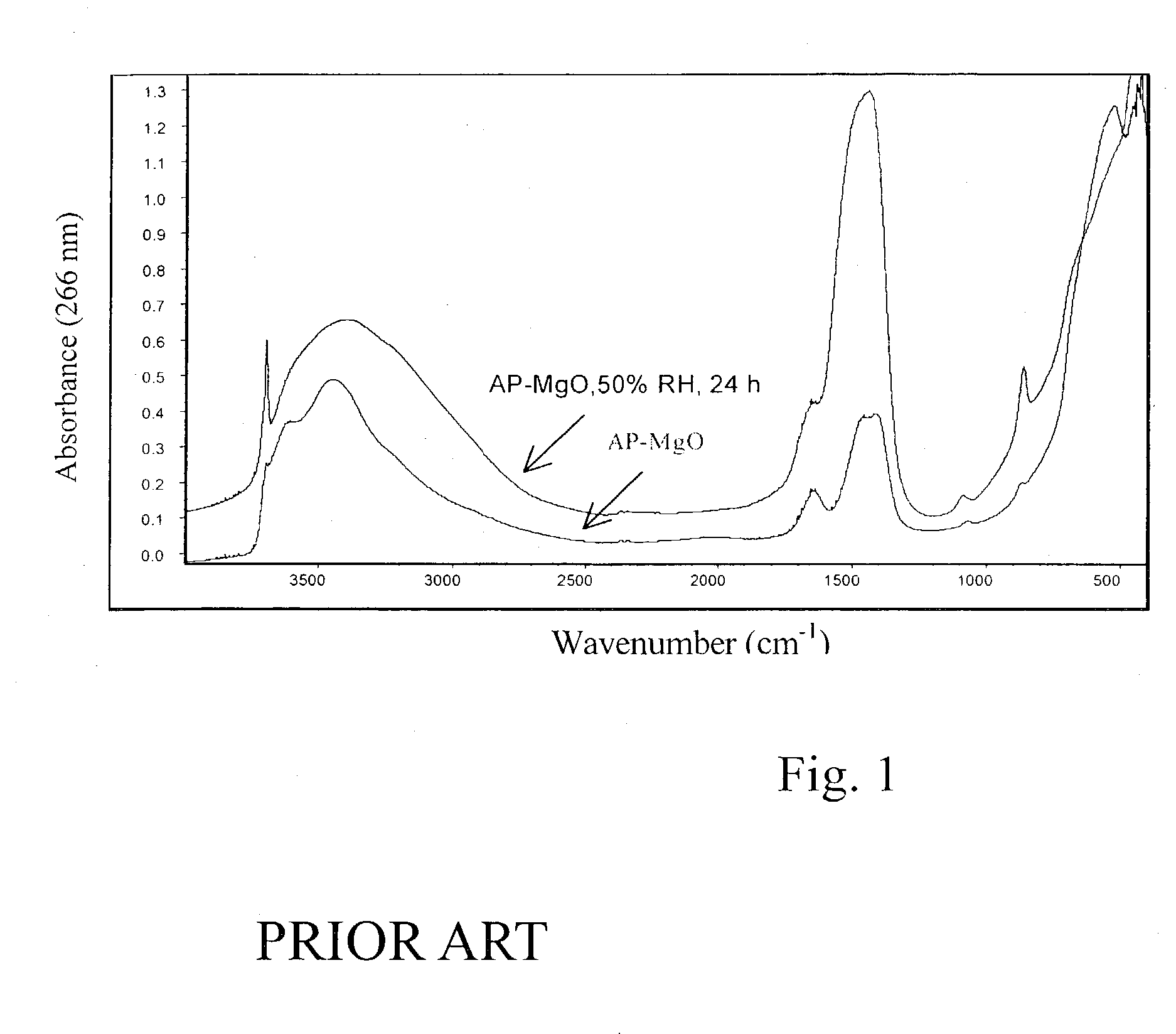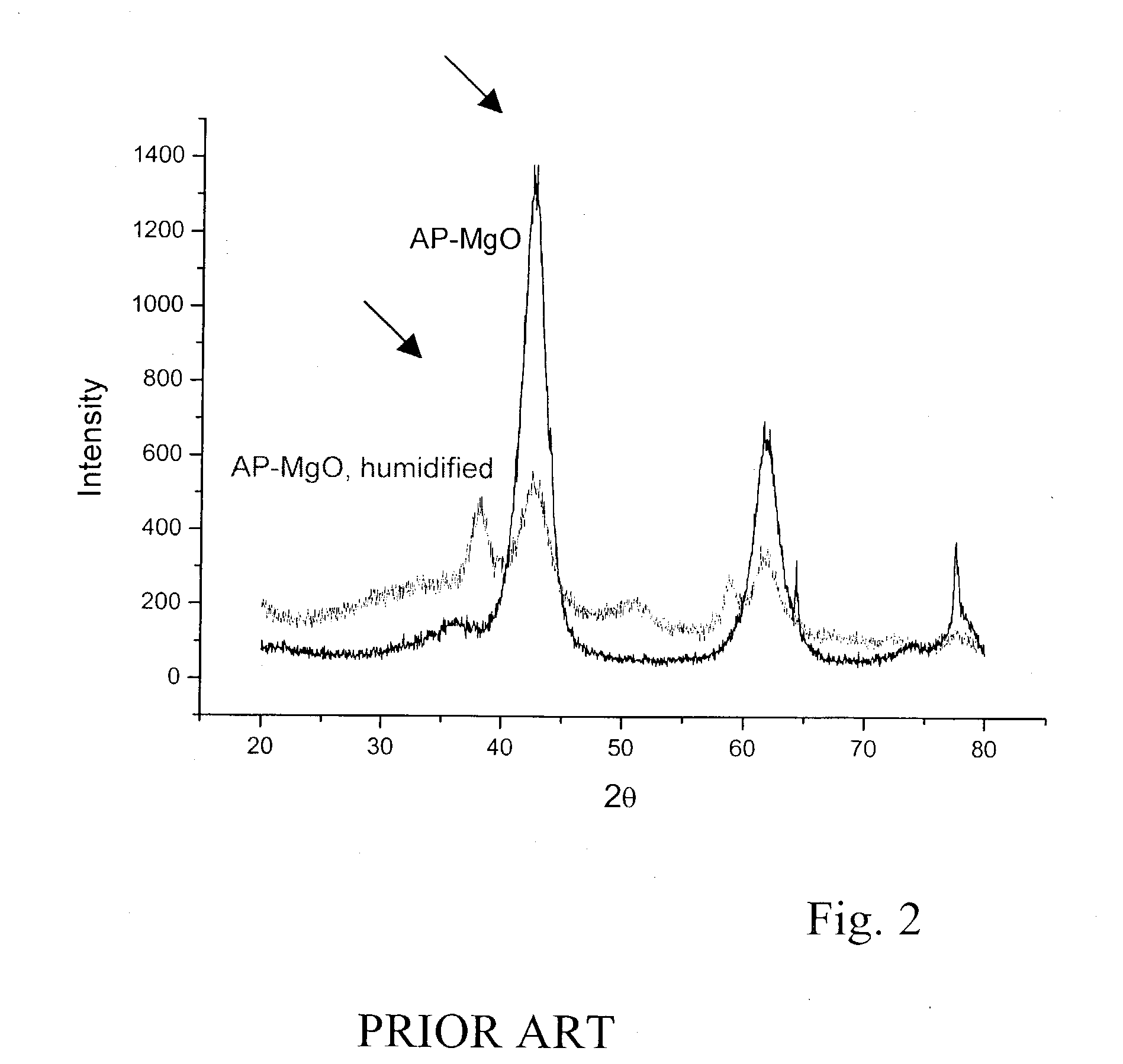Air-stable metal oxide nanoparticles
a technology of metal oxide nanoparticles and airstable metal oxides, which is applied in the direction of alkali metal oxides/hydroxides, other chemical processes, separation processes, etc., can solve the problems of appreciable reactivity loss, and achieve the effect of effective airborne decontamination of chemical substances
- Summary
- Abstract
- Description
- Claims
- Application Information
AI Technical Summary
Benefits of technology
Problems solved by technology
Method used
Image
Examples
example 1
Magnesium Oxide Nanoparticles Coated with a Surfactant
1. Preparation of Materials
Several 1 g samples of magnesium oxide nanoparticles were individually coated with from 1-20% by weight of a hydrocarbon-based surfactant. This was accomplished by adding the magnesium oxide nanoparticles and the desired surfactant to a 250 mL, stoppered Erlenmeyer flask equipped with a stir bar and containing 50 mL of hexanes. The reaction mixture was stirred for 20 hours followed by centrifuging and drying in an oven 110° C. for one hour. The resulting samples were characterized by BET and XRD. The BET multi-point surface area was determined using N2 adsorption at liquid N2 temperature to measure the surface area / unit mass. The BET surface area measurement techniques are described in Introduction to Powder Surface Area, Lowell, S., John Wiley & Sons: New York (1979), incorporated by reference herein. Table 1 sets forth the results of this analysis, along with the particular surfactants that were u...
example 2
Magnesium Oxide Nanoparticles with Double Surfactant Coating
1. Materials and Methods
This procedure was carried out to determine whether the use of a double surfactant coating would improve on the results obtained in Example 1 above. In this procedure, 1 g of magnesium oxide nanoparticles and the desired surfactant were added to a 250 mL, stoppered Erlenmeyer flask equipped with a stir bar and containing 50 mL of hexanes. The mixture was stirred for 20-24 hours after which a second surfactant was added followed by further stirring for another 20-24 hours. The reaction mixture was then centrifuged and dried in an oven at 110° C. for 1 hour. BET multi-point surface area and XRD measurements were taken of the resulting samples. These results are shown in Table 3.
TABLE 3Weight gainuponSSA, m2 / gXRD patternhumiditybeforeafterbeforeafterEntrySurfactantexposure %humidityhumidityhumidityhumidity1AOT / DeZOLINE Tnda32360.0oxideoxide2AOT / Surfynol 104A2633080.9oxideoxide3DeZOLINE T / AOTnd3086...
example 3
Magnesium Oxide Nanoparticles Coated with Oil
1. Materials and Methods
In this procedure, respective samples of dry magnesium oxide particles (3.0 g) were mixed with 50% by weight of vegetable oil or mineral oil by mixing in a plastic cylindrical container. Mixing was carried out with a Dispermat mixer (about 600 rpm for about 1 minute, mixing with a spatula, then about 800 rpm for about 1 minute). The samples were then exposed to humidifying conditions following the procedure described above. The humidified samples were analyzed for weight gain as well as paraoxon reactivity (see Table 4).
TABLE 4Weight gainUVupon humidityHumidityabsorption readingEntryAdditiveexposure %exposure0.5 h2 h20 h1None67No000Yes1.781.651.312Mineral Oil38No000Yes0.330.1603Vegetable Oil26No1.721.500.63Yes1.961.971.45
Both the vegetable oil and mineral oil resulted in an appreciable reduction in weight gain upon humidity exposure. While the vegetable oil-coated samples reacted poorly with paraoxon both be...
PUM
| Property | Measurement | Unit |
|---|---|---|
| crystallite size | aaaaa | aaaaa |
| temperature | aaaaa | aaaaa |
| RH | aaaaa | aaaaa |
Abstract
Description
Claims
Application Information
 Login to View More
Login to View More - R&D
- Intellectual Property
- Life Sciences
- Materials
- Tech Scout
- Unparalleled Data Quality
- Higher Quality Content
- 60% Fewer Hallucinations
Browse by: Latest US Patents, China's latest patents, Technical Efficacy Thesaurus, Application Domain, Technology Topic, Popular Technical Reports.
© 2025 PatSnap. All rights reserved.Legal|Privacy policy|Modern Slavery Act Transparency Statement|Sitemap|About US| Contact US: help@patsnap.com



